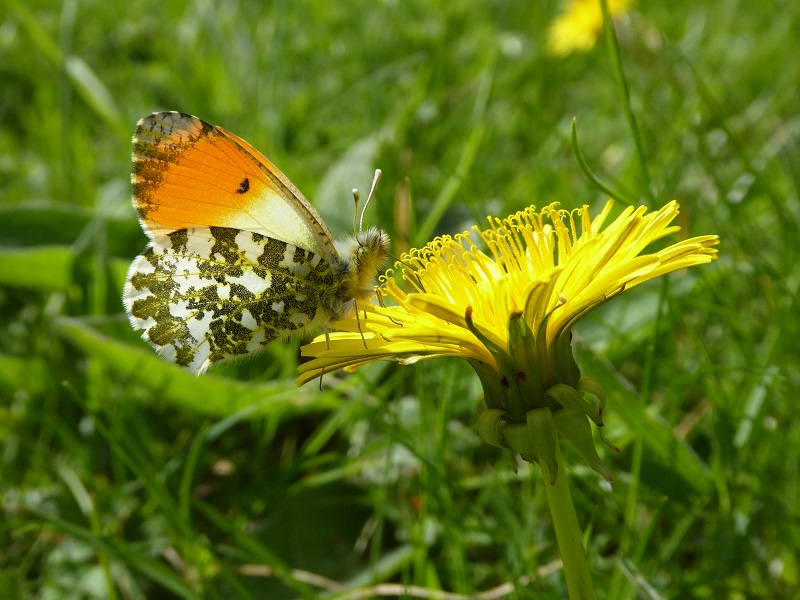In Ireland, we have four butterfly species that over-winter in the adult form. We have a number of moths that hibernate as adults. One of these is the iconic Herald moth. A group of this species will sometimes shelter in your attic to wait for spring.
One of our butterflies has a habit of entering rooms in houses to pass the winter. The Small Tortoiseshell, a beautifully marked butterfly likes to stay close to us in late summer and will even stake out likely hibernation sites indoors especially during August and September before settling to fold its wings for winter in some obscure spot in our homes, sheds or even cars! This well-studied butterfly has some fascinating characteristics. It has shown an ability to relocate specific sites when it has been disturbed from the site, suggesting a spatial memory; if a nettle on which a female is laying her eggs is moved, the female returns to the spot where the nettle was located, not to the site it was removed to. The butterfly is very mobile and some of ‘our’ Small Tortoiseshells may have travelled from Britain and Europe. Males establish and defend territories but if he finds a female he switches to defending the female from other males. She makes him work hard by flying away at speed to see if he can keep up and sometimes by flying into territory held by other males so that her suitor may have to fight several males throughout the rest of the day. He will drive them away by engaging in a series of aerial combats, with high altitude climbs when he tries to fly above the intruder. When the intruder is expelled, the male returns to his female who usually remains perched where he left her. Sometimes, though, she gives him the slip, giving him an anxious search as he inspects the surrounding nettle bed for her. Some females hide, and later accept defence by another male. Even a female who has cooperated with a male all day tries to lose him when she goes to roost in the nettles in the evening by dropping into the nettles and running along the ground. If the male manages to stay with her, she suddenly becomes quiet and allows mating, which lasts all night. Presumably, her demanding behaviour ensures that only the fittest males father offspring, ensuring the health of the next generation. This provides a fascinating example of selection by the female of the fittest male.
Another, related feature of the butterfly is its impressive longevity. The over-wintering generation is long-lived, and individuals can survive 10 months. The impressive life-span allows the female Small Tortoiseshell the chance to be selective; most female butterflies accept the first male encountered; these females lack the luxury of an extended life to test male powers of endurance.
However, our Small Tortoiseshells have one significant challenge when they enter our homes to see out the winter in our bedrooms, living rooms and hallways. The butterflies are very careful to select the best spots, picking excellent hiding places in curtain folds, behind mirrors and pictures, in unused chimney brests, behind dressers and, to complete the concealment, their dark cryptic coloured undersides blend nicely with their chosen surface. However, the mod con that is central heating confounds their attempts to complete their winter slumber. Heat rouses the butterfly, causing it to believe that spring, with its sunshine, flowers and nettles beckon it to fly outdoors. The confused butterfly flies around lights and windows, trying to get out.
Householders who release the butterfly into the winter are usually dooming it. The butterfly rapidly loses the ability to fly when its body temperature plummets in the cold and is picked off by birds or mammals. The other problem is starvation. The butterfly built up vital fats by gorging on nectar in our gardens and countryside before switching off for winter and long periods of unseasonable activity reduces these reserves.
What should you do if you encounter an active Small Tortoiseshell in your home?
If this happens in warm spring weather release the butterfly in the knowledge that it’s time to let it go. It is now ready to feed on the spring flowers, move in search of territories, breeding grounds and mates.
If the butterfly wakes up in winter it should be placed in a dry, transparent container lined with a folded section of kitchen roll to absorb moisture and placed in the salad drawer in the fridge, where the temperature is around four Celsius. The butterfly will soon settle and can be kept there until warm, sunny weather arrives in March or April. Alternatively, remove the butterfly from the container when it is quiet and place in an unheated shed or room to complete its winter rest.
If the butterfly has been flying around for some time, it may need to be fed. Dissolve sugar or honey in hot water, allow it to cool and use a cotton pad to absorb the sweetened solution. When cool, place the calmed butterfly (cooled in the salad drawer but not long enough to be made fully docile) on the pad, in softly-lit mild conditions. It should begin to feed. When it has finished, place in a cool place to sleep.
Over the years I have successfully over-wintered adult Small Tortoiseshells and felt a burst of delight to watch the butterfly surge into the sunshine in spring. Interestingly, the released butterfly does not loiter. It flies strongly away, as though hyper-energised by the promise of brightness and freshness of a world renewed by the return of sunshine.





